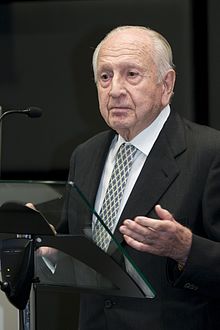Antonio Lamela
| Antonio Lamela | |
|---|---|

Antonio Lamela in 2010
|
|
| Born |
December 1, 1926 Madrid, Spain |
| Died | April 1, 2017 (aged 90) Madrid, Spain |
| Nationality | Spanish |
| Alma mater | Technical University of Madrid |
| Occupation | Architect |
| Practice | Estudio Lamela |
| Buildings |
Santiago Bernabéu Stadium Adolfo Suárez Madrid–Barajas Airport Torres de Colón |
Antonio Lamela (December 1, 1926 – April 1, 2017) was a Spanish architect.
Lamela was born in Madrid. He graduated from the Technical School of Architecture of Madrid (ETSAM) in 1954 and received his doctorate in 1959. From the beginning of his professional career he proved to be a visionary and innovative architect, the result of his great professional curiosity and much global travelling.
In 1965 Antonio Lamela introduced ready-mixed concrete to Spain through the Prebetong brand. The company soon expanded into different geographical areas (Madrid, Aragon, Costa del Sol, Baleares and Canary Islands). In practice, they were the first concrete-mixer trucks to circulate on Spanish roads.
In 1968 he started the company Shockbeton, dedicated to making pieces of architectural concrete. It was the first time in Spain that concrete prefabricated structures for facades were created, with results of great technical and aesthetic importance. Another of the leading companies that he launched in those years is CTC, a pioneering firm in the industrial supply of packaged bricks.
In Madrid, Antonio Lamela concluded two reference works. The first was the remodelling and extension in 1988 of the Santiago Bernabéu Stadium (Lamela holds membership number 59 for Real Madrid Football Club).
The second is the award-winning Terminal 4 of the Barajas Airport (since 2014, the Adolfo Suárez Madrid-Barajas Airport), along with Richard Rogers.
In 1976 Lamela founded in Spain the Club of Rome, an international organization that seeks to improve the world with tools such as education, social integration and the fair and equitable development of the planet.
Antonio Lamela has written several books and publications, as well as numerous papers, writings and essays on land use, water policies, conservation of the environment, and even on the protection of the Spanish language.
The architecture of Antonio Lamela is also a history of more than 1,500 projects and achievements of land use planning. Some have been collected in the book "Lamela: Urbanística y Arquitectura. Realizaciones y Proyectos 1954-1992"as well as in the supplement "Proyectos y Realizaciones 1990-2003". His architecture narrates by itself an entire epoch of the history of Spain.
...
Wikipedia
